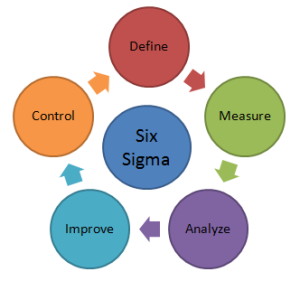Six Sigma:
 Six Sigma is a data-driven improvement philosophy that views all activities within an organization as processes whose inputs can be controlled to effect significant improvements in process outputs. Six Sigma uses a rigorous and systematic methodology known as DMAIC (define, measure, analyze, improve, and control) and a number of qualitative and quantitative tools for driving process, product, and service improvements aimed at reducing defects and variation.
Six Sigma is a data-driven improvement philosophy that views all activities within an organization as processes whose inputs can be controlled to effect significant improvements in process outputs. Six Sigma uses a rigorous and systematic methodology known as DMAIC (define, measure, analyze, improve, and control) and a number of qualitative and quantitative tools for driving process, product, and service improvements aimed at reducing defects and variation.
When Jack Welch, former General Electric CEO, introduced Six Sigma, he said:
We are going to shift the paradigm from fixing products to fixing and developing processes, so they produce nothing but perfection or close to it.
Sigma:
A sigma, or standard deviation, is a measure of variation that reveals the average difference between any one item and the overall average of a larger population of items.
Lean:
Lean is also an improvement methodology, but with a different focus. It enhances value for the customer by:
1. Improving and smoothing the process flow.
2. Reduce Cycle time and eliminate waste.
The concept of the word ‘Lean’ started in 1987, when John Krafcik (First chief executive for Google’s self-driving car project, a 25-year car industry veteran who previously led Hyundai’s business in the U.S.) was working as a researcher for MIT as part of the International Motor Vehicle Program. Krafcik needed a label for the TPS phenomenon that described what the system did. On a white board he wrote the performance attributes of the Toyota system compared with traditional mass production. TPS:
-
Needed less human effort to design products and services.
-
Required less investment for a given amount of production capacity.
-
Created products with fewer delivered defects.
-
Used fewer suppliers.
-
Went from concept to launch, order to delivery and problem to repair in less time and with less human effort.
-
Needed less inventory at every process step.
-
Caused fewer employee injuries.
Krafcik commented: It needs less of everything to create a given amount of value, so let’s call it Lean.
The Lean enterprise was born.
Lean and Six Sigma originated in different places and under different circumstances but now they are seen as complementary methodologies.
TPS (Toyota Production System):
The TPS approach is about understanding:
- How the work gets done
- Finding ways of doing it better, smoother and faster
- Closing the time gap between the start and end points of our processes.
Toyota’s Taiichi Ohno describes the TPS approach very effectively:
All we are doing is looking at a timeline from the moment the customer gives us an order to the point when we collect the cash. And we are reducing that timeline by removing the non-value-added wastes.
CTQ (Critical to Quality):
CTQ express the customers’ requirements in a way that is measurable. CTQs are a vital element in Lean Six Sigma and provide the basis of process measurement set.
While calculating sigma values for your processes, you need to understand these key terms:
-
Unit: The item produced or processed.
-
Defect: Any event that does not meet the specification of a CTQ.
-
Defect opportunity: Any event that provides a chance of not meeting a customer CTQ. The number of defect opportunities will equal the number of CTQs.
-
Defective: A unit with one or more defects.

Please comment with your real name using good manners.